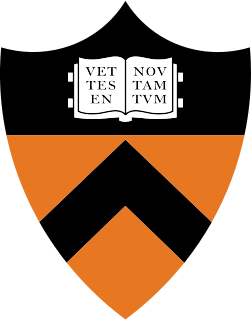
Princeton University is a private Ivy League research university in Princeton, New Jersey. Founded in 1746 in Elizabeth as the College of New Jersey, Princeton is the fourth-oldest institution of higher education in the United States and one of the nine colonial colleges chartered before the American Revolution. The institution moved to Newark in 1747, and then to the current site nine years later. It officially became a university in 1896 and was subsequently renamed Princeton University.

Campus Club was one of the undergraduate eating clubs at Princeton University. Located on the corner of Washington Road and Prospect Avenue, Campus was founded in 1900. It was one of the eating clubs that abandoned the selective bicker process to choose members non-selectively, a status it held for over twenty years.
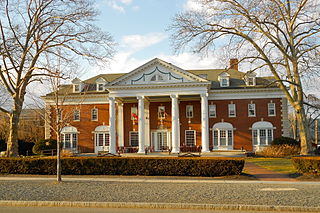
Colonial Club is one of the eleven current eating clubs of Princeton University in Princeton, New Jersey, United States. Founded in 1891, it is the fifth oldest of the clubs. It is located on 40 Prospect Avenue.

The Ivy Club, often simply Ivy, is the oldest eating club at Princeton University, and it is "still considered the most prestigious" by its members. It was founded in 1879 with Arthur Hawley Scribner as its first head. Ivy is one of the "Big Four" eating clubs at Princeton, the four oldest and most prestigious on campus.

Nassau Hall is the oldest building at Princeton University in Princeton, Mercer County, New Jersey, United States. In 1783 it served as the United States Capitol building for four months. At the time it was built in 1756, Nassau Hall was the largest building in colonial New Jersey and the largest academic building in the American colonies.

Moses Taylor Pyne, was a financier and philanthropist, and one of Princeton University's greatest benefactors and its most influential trustee.

The Nassau Presbyterian Church is a historic congregation located at 61 Nassau Street in Princeton, New Jersey, United States. It has been the home of many important figures in the history of Presbyterianism in the United States as a result of its proximity to Princeton University and the Princeton Theological Seminary. The church operates the Princeton Cemetery and is a contributing property to the Princeton Historic District. The current pastor is The Reverend Dr. David A. Davis.

First College, the first of Princeton University's six residential colleges, was developed in the late 1950s when a group of students formed the Woodrow Wilson Lodge as an alternative to the eating clubs. The Woodrow Wilson Lodge members originally met and dined in Madison Hall, which is now part of John D. Rockefeller III College. Inspired by the ideas of Woodrow Wilson, president of Princeton from 1902–1910, the members advocated a more thorough integration of academic, social and residential life on campus.

The University Cottage Club or simply Cottage Club is one of eleven current eating clubs at Princeton University, in Princeton, New Jersey, United States. It is also one of the six bicker clubs, along with The Ivy Club, Tiger Inn, Cap and Gown Club, Cannon Club and Tower Club.

The California Club is a by-invitation members-only private club established in 1888 which is the second-oldest such club in Southern California. The club's clubhouse was listed on the National Register of Historic Places in 2010.

Palmer Square is a public square and planned development in the heart of Princeton, New Jersey across from Nassau Street and Princeton University that today forms a collection of shops, restaurants, offices and residential spaces.
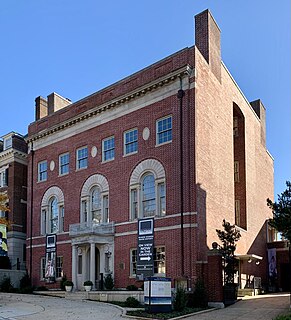
The Woodrow Wilson House was the residence of the Twenty-Eighth President of the United States, Woodrow Wilson after he left office. It is at 2340 S Street NW just off Washington, D.C.'s Embassy Row. On February 3, 1924, Wilson died in an upstairs bedroom. It was designated a National Historic Landmark in 1964. The National Trust for Historic Preservation owns the house and operates it as a museum.

Aymar Embury II was an American architect. He is best known for commissions from the City of New York from the 1930s through to the 1950s. In this period, Embury frequently worked with Robert Moses in the latter's various city and state capacities, especially, early on, in Moses’ capacity as New York City Parks Commissioner. Many surviving examples of Embury's work are zoos, swimming pools, playgrounds, and other recreational structures in New York City parks.

Merion Cricket Club is a private club in Haverford, Pennsylvania, founded in 1865. The current clubhouse is its sixth, the last four having been designed by Philadelphia architect Frank Furness and his partner, Allen Evans, who was also a founder of the club. The club was designated a National Historic Landmark in 1987 for its leading role in the promotion, development and continued support of cricket, golf, squash, and tennis in the United States.
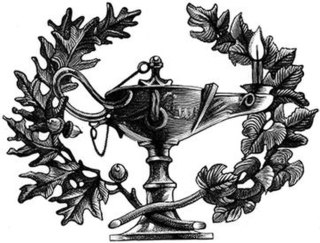
The Century Association is a private social, arts, and dining club in New York City, founded in 1847. Its clubhouse is located at 7 West 43rd Street near Fifth Avenue in Midtown Manhattan. It is primarily a club for men and women with distinction in literature or the arts. The Century Association was founded by members of New York's Sketch Club; preceding clubs also included the National Academy of Design, the Bread and Cheese Club, and the Column. Traditionally a men's club, women first became active in club life in the early 1900s; the organization began admitting women as members in 1988.
Princeton University was founded in Elizabeth, New Jersey, in 1746 as the College of New Jersey, shortly before moving into the newly built Nassau Hall in Princeton. In 1783, for about four months Nassau Hall hosted the United States Congress, and many of the students went on to become leaders of the young republic.

Prospect House, known also as just Prospect, is a historic house on the Princeton University campus in Princeton, Mercer County, New Jersey, United States. Built in 1851, it is a fine example of the work of architect John Notman who helped popularize Italianate architecture in America. Notable residents include Woodrow Wilson during his tenure as president of the university. The building now serves as a faculty club. It was designated a National Historic Landmark in 1985 for its architecture and historic associations.

The President's House, also known as the John Maclean House, or simply the Maclean House, in Princeton, Mercer County, New Jersey, United States, was built to serve as the home of the President of the College of New Jersey, which later became Princeton University. It was completed in 1756, the same year as Nassau Hall. John Witherspoon lived here from 1768 through 1779, during which time he served as a delegate to the Continental Congress and signed the Declaration of Independence. George Washington occupied Maclean House in January 1777, during the Battle of Princeton and in 1783 while Congress met in Nassau Hall.
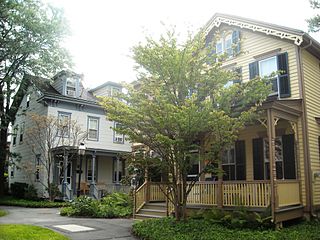
The Princeton Historic District is a 370-acre (150 ha) historic district located in Princeton, New Jersey that was listed on the U.S. National Register of Historic Places in 1975. It stretches from Marquand Park in the west to the Eating Clubs in the East, from the Princeton Cemetery in the north to the Graduate College in the south. The district encompasses the core parts of the campuses of the Princeton Theological Seminary and Princeton University. It also includes the business district centered on Nassau Street and many historic homes, both mansions in the western section and more humble dwellings in the Witherspoon/Jackson neighborhood. Notable churches within the district include Nassau Presbyterian Church, Trinity Episcopal, Nassau Christian Center, and the Princeton University Chapel. The district is home to seven of Princeton's nine, and New Jersey's fifty-eight, National Historic Landmarks, the largest concentration of such sites in the state.

Cannon Club, also known as Cannon Dial Elm Club, is one of the historic Eating Clubs at Princeton University. Founded in 1895, it completed its current clubhouse in 1910. The club closed in the early 1970s and later merged with Dial Lodge and Elm Club to form Dial, Elm, Cannon (DEC), which closed its doors in 1998. In 2011 DEC reopened, now bearing the name Cannon Dial Elm Club, using its historic clubhouse, which had served as the home for the Office of Population Research during the club's hiatus.





















